Financial Accounting Report: Financial Statements and Reconciliation
VerifiedAdded on 2021/02/22
|19
|4976
|94
Report
AI Summary
This report provides a comprehensive analysis of financial accounting, focusing on the preparation of final accounts for sole traders, partnerships, and limited companies. It includes detailed income statements and balance sheets, alongside explanations of key financial statement features, their purposes, structures, and content. The report also delves into the process of bank reconciliation, its importance in verifying general accounts and balance sheets, and the reconciliation of control and suspense accounts. Through these analyses, the report offers insights into the financial performance and position of different business structures and the critical role of accurate financial reporting in decision-making for stakeholders. The report demonstrates the application of accounting principles, conventions, and standards to ensure the accuracy and reliability of financial data, and is a valuable resource for understanding financial accounting practices. The report is contributed by a student and available on Desklib, a platform providing AI-based study tools for students.
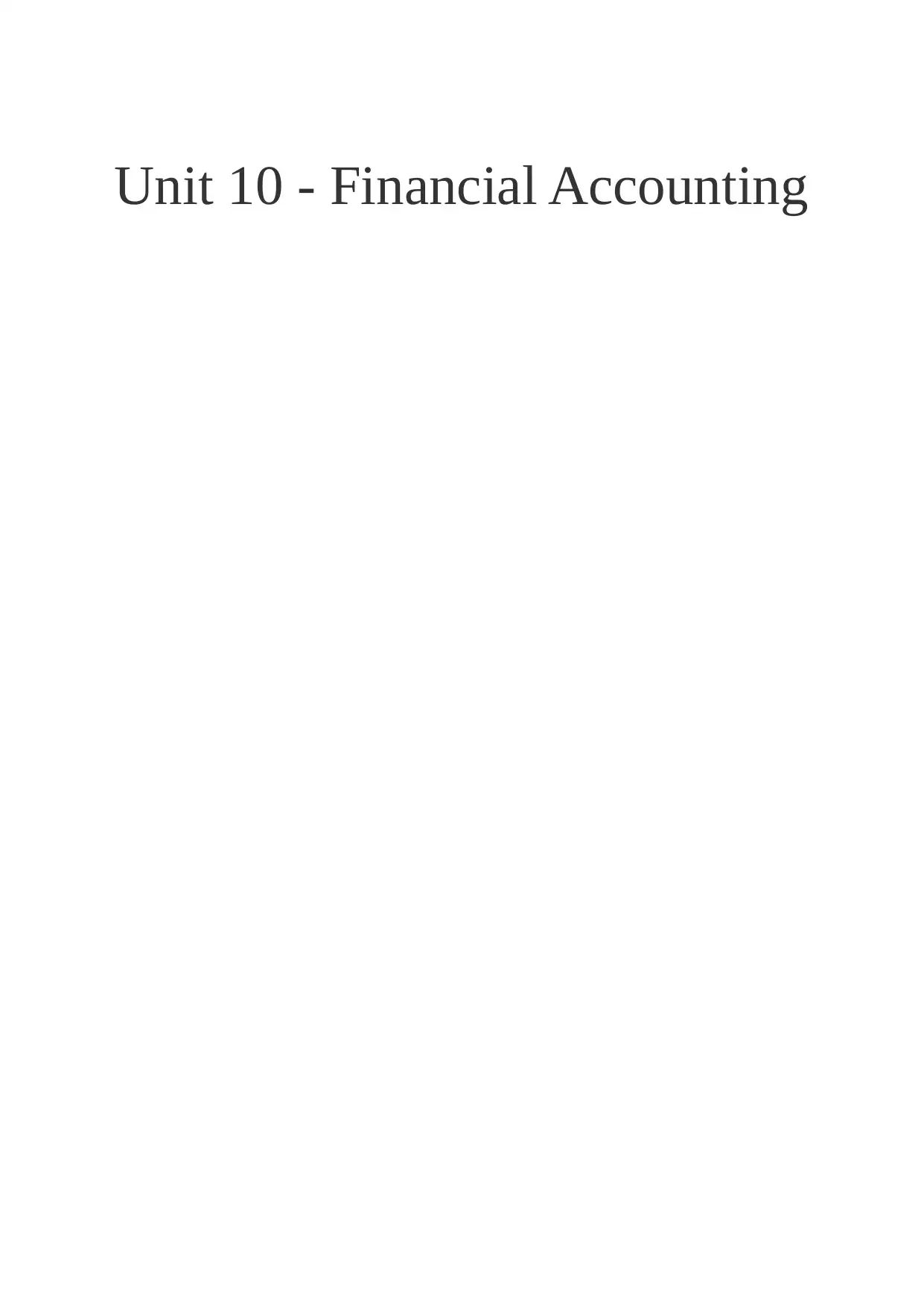
Unit 10 - Financial Accounting
Paraphrase This Document
Need a fresh take? Get an instant paraphrase of this document with our AI Paraphraser
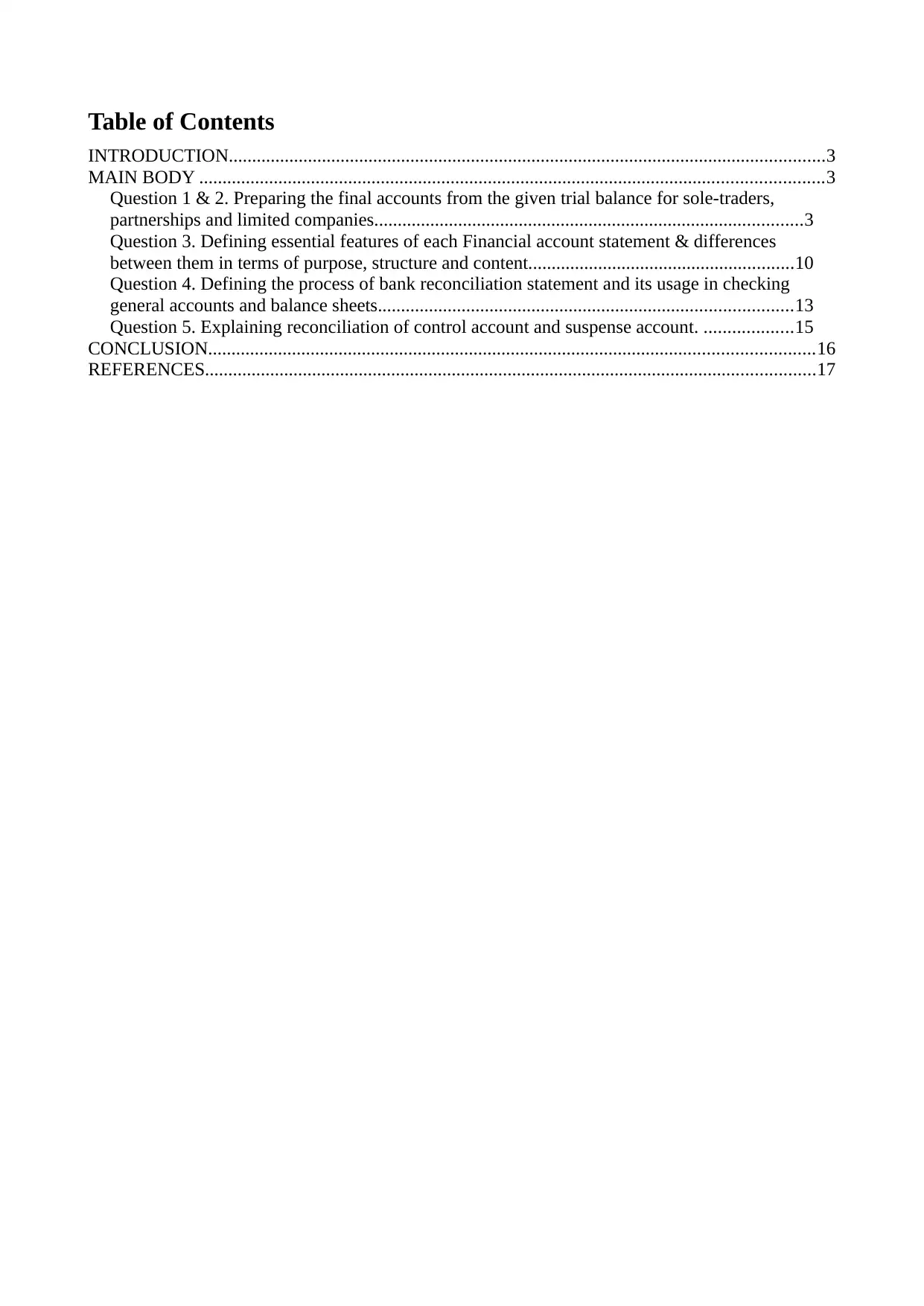
Table of Contents
INTRODUCTION................................................................................................................................3
MAIN BODY ......................................................................................................................................3
Question 1 & 2. Preparing the final accounts from the given trial balance for sole-traders,
partnerships and limited companies............................................................................................3
Question 3. Defining essential features of each Financial account statement & differences
between them in terms of purpose, structure and content.........................................................10
Question 4. Defining the process of bank reconciliation statement and its usage in checking
general accounts and balance sheets.........................................................................................13
Question 5. Explaining reconciliation of control account and suspense account. ...................15
CONCLUSION..................................................................................................................................16
REFERENCES...................................................................................................................................17
INTRODUCTION................................................................................................................................3
MAIN BODY ......................................................................................................................................3
Question 1 & 2. Preparing the final accounts from the given trial balance for sole-traders,
partnerships and limited companies............................................................................................3
Question 3. Defining essential features of each Financial account statement & differences
between them in terms of purpose, structure and content.........................................................10
Question 4. Defining the process of bank reconciliation statement and its usage in checking
general accounts and balance sheets.........................................................................................13
Question 5. Explaining reconciliation of control account and suspense account. ...................15
CONCLUSION..................................................................................................................................16
REFERENCES...................................................................................................................................17
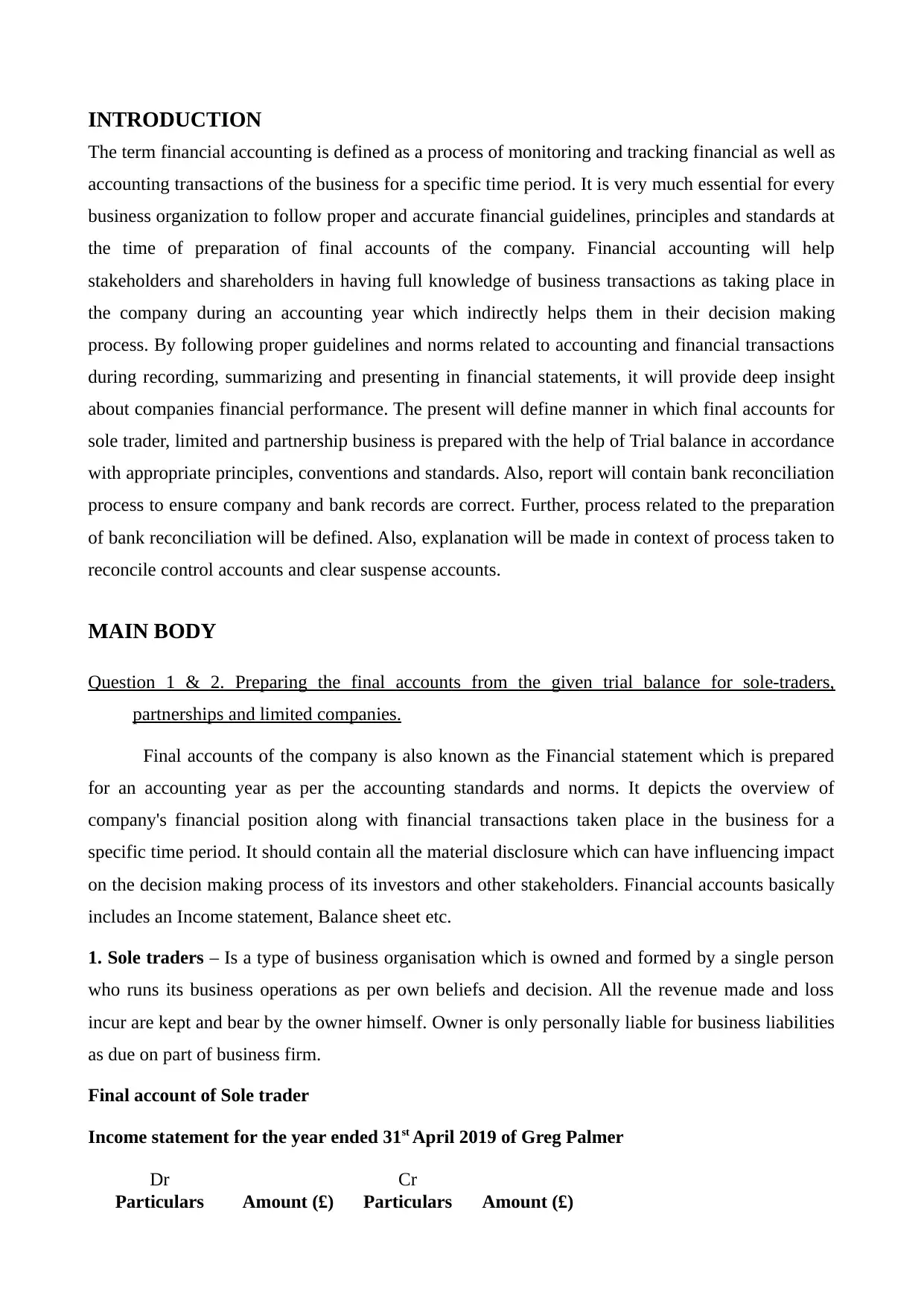
INTRODUCTION
The term financial accounting is defined as a process of monitoring and tracking financial as well as
accounting transactions of the business for a specific time period. It is very much essential for every
business organization to follow proper and accurate financial guidelines, principles and standards at
the time of preparation of final accounts of the company. Financial accounting will help
stakeholders and shareholders in having full knowledge of business transactions as taking place in
the company during an accounting year which indirectly helps them in their decision making
process. By following proper guidelines and norms related to accounting and financial transactions
during recording, summarizing and presenting in financial statements, it will provide deep insight
about companies financial performance. The present will define manner in which final accounts for
sole trader, limited and partnership business is prepared with the help of Trial balance in accordance
with appropriate principles, conventions and standards. Also, report will contain bank reconciliation
process to ensure company and bank records are correct. Further, process related to the preparation
of bank reconciliation will be defined. Also, explanation will be made in context of process taken to
reconcile control accounts and clear suspense accounts.
MAIN BODY
Question 1 & 2. Preparing the final accounts from the given trial balance for sole-traders,
partnerships and limited companies.
Final accounts of the company is also known as the Financial statement which is prepared
for an accounting year as per the accounting standards and norms. It depicts the overview of
company's financial position along with financial transactions taken place in the business for a
specific time period. It should contain all the material disclosure which can have influencing impact
on the decision making process of its investors and other stakeholders. Financial accounts basically
includes an Income statement, Balance sheet etc.
1. Sole traders – Is a type of business organisation which is owned and formed by a single person
who runs its business operations as per own beliefs and decision. All the revenue made and loss
incur are kept and bear by the owner himself. Owner is only personally liable for business liabilities
as due on part of business firm.
Final account of Sole trader
Income statement for the year ended 31st April 2019 of Greg Palmer
Dr Cr
Particulars Amount (£) Particulars Amount (£)
The term financial accounting is defined as a process of monitoring and tracking financial as well as
accounting transactions of the business for a specific time period. It is very much essential for every
business organization to follow proper and accurate financial guidelines, principles and standards at
the time of preparation of final accounts of the company. Financial accounting will help
stakeholders and shareholders in having full knowledge of business transactions as taking place in
the company during an accounting year which indirectly helps them in their decision making
process. By following proper guidelines and norms related to accounting and financial transactions
during recording, summarizing and presenting in financial statements, it will provide deep insight
about companies financial performance. The present will define manner in which final accounts for
sole trader, limited and partnership business is prepared with the help of Trial balance in accordance
with appropriate principles, conventions and standards. Also, report will contain bank reconciliation
process to ensure company and bank records are correct. Further, process related to the preparation
of bank reconciliation will be defined. Also, explanation will be made in context of process taken to
reconcile control accounts and clear suspense accounts.
MAIN BODY
Question 1 & 2. Preparing the final accounts from the given trial balance for sole-traders,
partnerships and limited companies.
Final accounts of the company is also known as the Financial statement which is prepared
for an accounting year as per the accounting standards and norms. It depicts the overview of
company's financial position along with financial transactions taken place in the business for a
specific time period. It should contain all the material disclosure which can have influencing impact
on the decision making process of its investors and other stakeholders. Financial accounts basically
includes an Income statement, Balance sheet etc.
1. Sole traders – Is a type of business organisation which is owned and formed by a single person
who runs its business operations as per own beliefs and decision. All the revenue made and loss
incur are kept and bear by the owner himself. Owner is only personally liable for business liabilities
as due on part of business firm.
Final account of Sole trader
Income statement for the year ended 31st April 2019 of Greg Palmer
Dr Cr
Particulars Amount (£) Particulars Amount (£)
⊘ This is a preview!⊘
Do you want full access?
Subscribe today to unlock all pages.

Trusted by 1+ million students worldwide
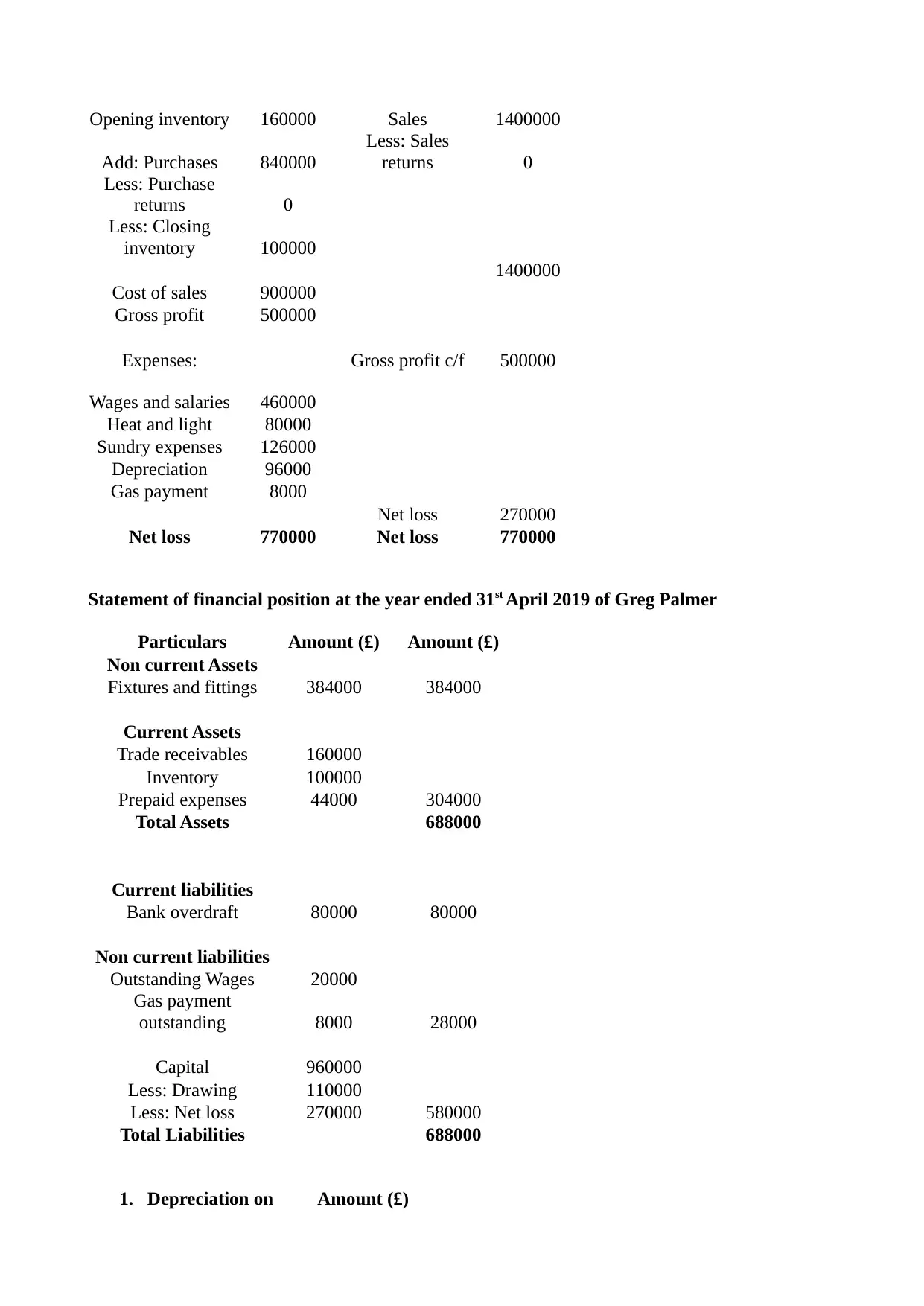
Opening inventory 160000 Sales 1400000
Add: Purchases 840000
Less: Sales
returns 0
Less: Purchase
returns 0
Less: Closing
inventory 100000
1400000
Cost of sales 900000
Gross profit 500000
Expenses: Gross profit c/f 500000
Wages and salaries 460000
Heat and light 80000
Sundry expenses 126000
Depreciation 96000
Gas payment 8000
Net loss 270000
Net loss 770000 Net loss 770000
Statement of financial position at the year ended 31st April 2019 of Greg Palmer
Particulars Amount (£) Amount (£)
Non current Assets
Fixtures and fittings 384000 384000
Current Assets
Trade receivables 160000
Inventory 100000
Prepaid expenses 44000 304000
Total Assets 688000
Current liabilities
Bank overdraft 80000 80000
Non current liabilities
Outstanding Wages 20000
Gas payment
outstanding 8000 28000
Capital 960000
Less: Drawing 110000
Less: Net loss 270000 580000
Total Liabilities 688000
1. Depreciation on Amount (£)
Add: Purchases 840000
Less: Sales
returns 0
Less: Purchase
returns 0
Less: Closing
inventory 100000
1400000
Cost of sales 900000
Gross profit 500000
Expenses: Gross profit c/f 500000
Wages and salaries 460000
Heat and light 80000
Sundry expenses 126000
Depreciation 96000
Gas payment 8000
Net loss 270000
Net loss 770000 Net loss 770000
Statement of financial position at the year ended 31st April 2019 of Greg Palmer
Particulars Amount (£) Amount (£)
Non current Assets
Fixtures and fittings 384000 384000
Current Assets
Trade receivables 160000
Inventory 100000
Prepaid expenses 44000 304000
Total Assets 688000
Current liabilities
Bank overdraft 80000 80000
Non current liabilities
Outstanding Wages 20000
Gas payment
outstanding 8000 28000
Capital 960000
Less: Drawing 110000
Less: Net loss 270000 580000
Total Liabilities 688000
1. Depreciation on Amount (£)
Paraphrase This Document
Need a fresh take? Get an instant paraphrase of this document with our AI Paraphraser
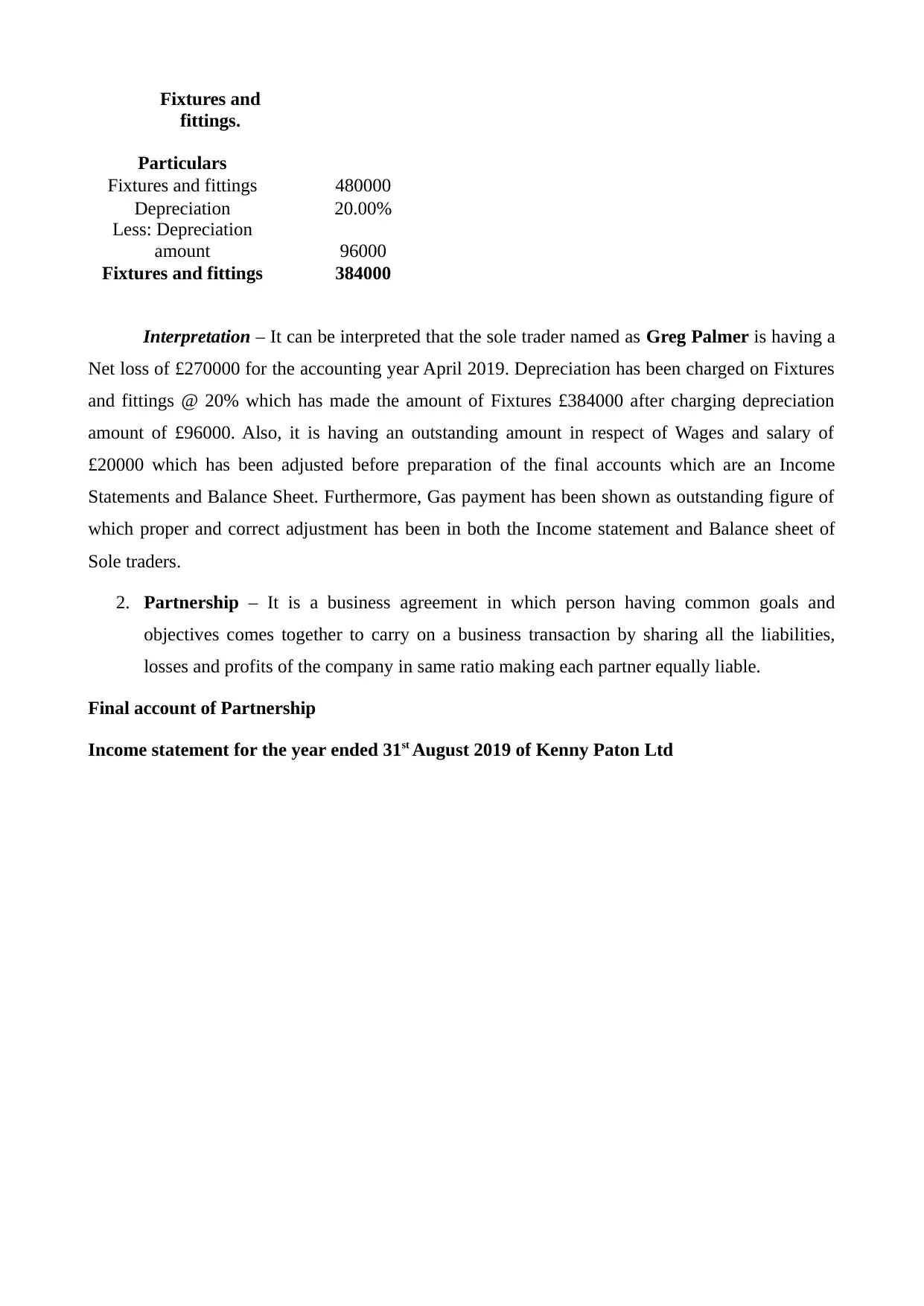
Fixtures and
fittings.
Particulars
Fixtures and fittings 480000
Depreciation 20.00%
Less: Depreciation
amount 96000
Fixtures and fittings 384000
Interpretation – It can be interpreted that the sole trader named as Greg Palmer is having a
Net loss of £270000 for the accounting year April 2019. Depreciation has been charged on Fixtures
and fittings @ 20% which has made the amount of Fixtures £384000 after charging depreciation
amount of £96000. Also, it is having an outstanding amount in respect of Wages and salary of
£20000 which has been adjusted before preparation of the final accounts which are an Income
Statements and Balance Sheet. Furthermore, Gas payment has been shown as outstanding figure of
which proper and correct adjustment has been in both the Income statement and Balance sheet of
Sole traders.
2. Partnership – It is a business agreement in which person having common goals and
objectives comes together to carry on a business transaction by sharing all the liabilities,
losses and profits of the company in same ratio making each partner equally liable.
Final account of Partnership
Income statement for the year ended 31st August 2019 of Kenny Paton Ltd
fittings.
Particulars
Fixtures and fittings 480000
Depreciation 20.00%
Less: Depreciation
amount 96000
Fixtures and fittings 384000
Interpretation – It can be interpreted that the sole trader named as Greg Palmer is having a
Net loss of £270000 for the accounting year April 2019. Depreciation has been charged on Fixtures
and fittings @ 20% which has made the amount of Fixtures £384000 after charging depreciation
amount of £96000. Also, it is having an outstanding amount in respect of Wages and salary of
£20000 which has been adjusted before preparation of the final accounts which are an Income
Statements and Balance Sheet. Furthermore, Gas payment has been shown as outstanding figure of
which proper and correct adjustment has been in both the Income statement and Balance sheet of
Sole traders.
2. Partnership – It is a business agreement in which person having common goals and
objectives comes together to carry on a business transaction by sharing all the liabilities,
losses and profits of the company in same ratio making each partner equally liable.
Final account of Partnership
Income statement for the year ended 31st August 2019 of Kenny Paton Ltd
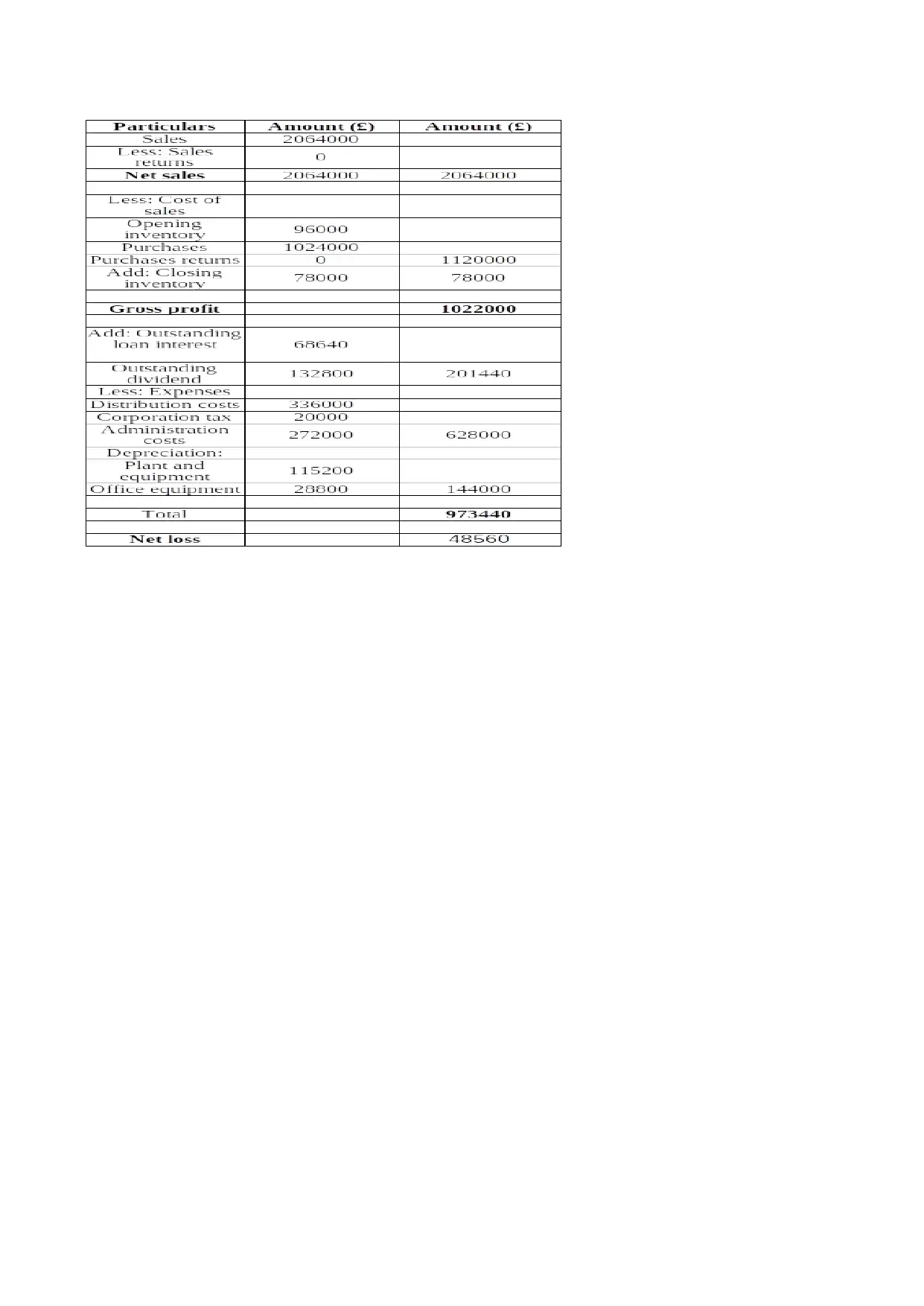
⊘ This is a preview!⊘
Do you want full access?
Subscribe today to unlock all pages.

Trusted by 1+ million students worldwide
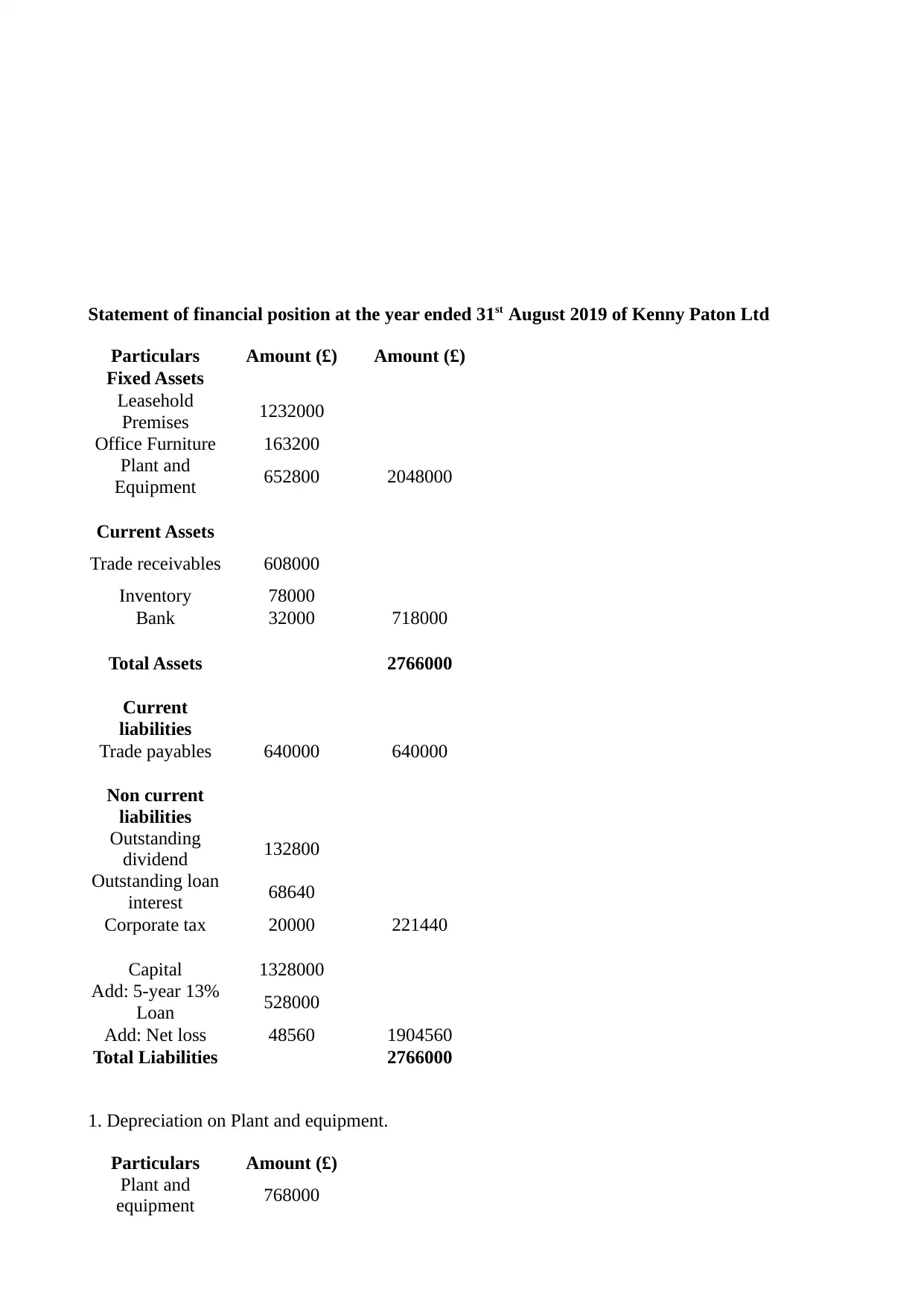
Statement of financial position at the year ended 31st August 2019 of Kenny Paton Ltd
Particulars Amount (£) Amount (£)
Fixed Assets
Leasehold
Premises 1232000
Office Furniture 163200
Plant and
Equipment 652800 2048000
Current Assets
Trade receivables 608000
Inventory 78000
Bank 32000 718000
Total Assets 2766000
Current
liabilities
Trade payables 640000 640000
Non current
liabilities
Outstanding
dividend 132800
Outstanding loan
interest 68640
Corporate tax 20000 221440
Capital 1328000
Add: 5-year 13%
Loan 528000
Add: Net loss 48560 1904560
Total Liabilities 2766000
1. Depreciation on Plant and equipment.
Particulars Amount (£)
Plant and
equipment 768000
Particulars Amount (£) Amount (£)
Fixed Assets
Leasehold
Premises 1232000
Office Furniture 163200
Plant and
Equipment 652800 2048000
Current Assets
Trade receivables 608000
Inventory 78000
Bank 32000 718000
Total Assets 2766000
Current
liabilities
Trade payables 640000 640000
Non current
liabilities
Outstanding
dividend 132800
Outstanding loan
interest 68640
Corporate tax 20000 221440
Capital 1328000
Add: 5-year 13%
Loan 528000
Add: Net loss 48560 1904560
Total Liabilities 2766000
1. Depreciation on Plant and equipment.
Particulars Amount (£)
Plant and
equipment 768000
Paraphrase This Document
Need a fresh take? Get an instant paraphrase of this document with our AI Paraphraser
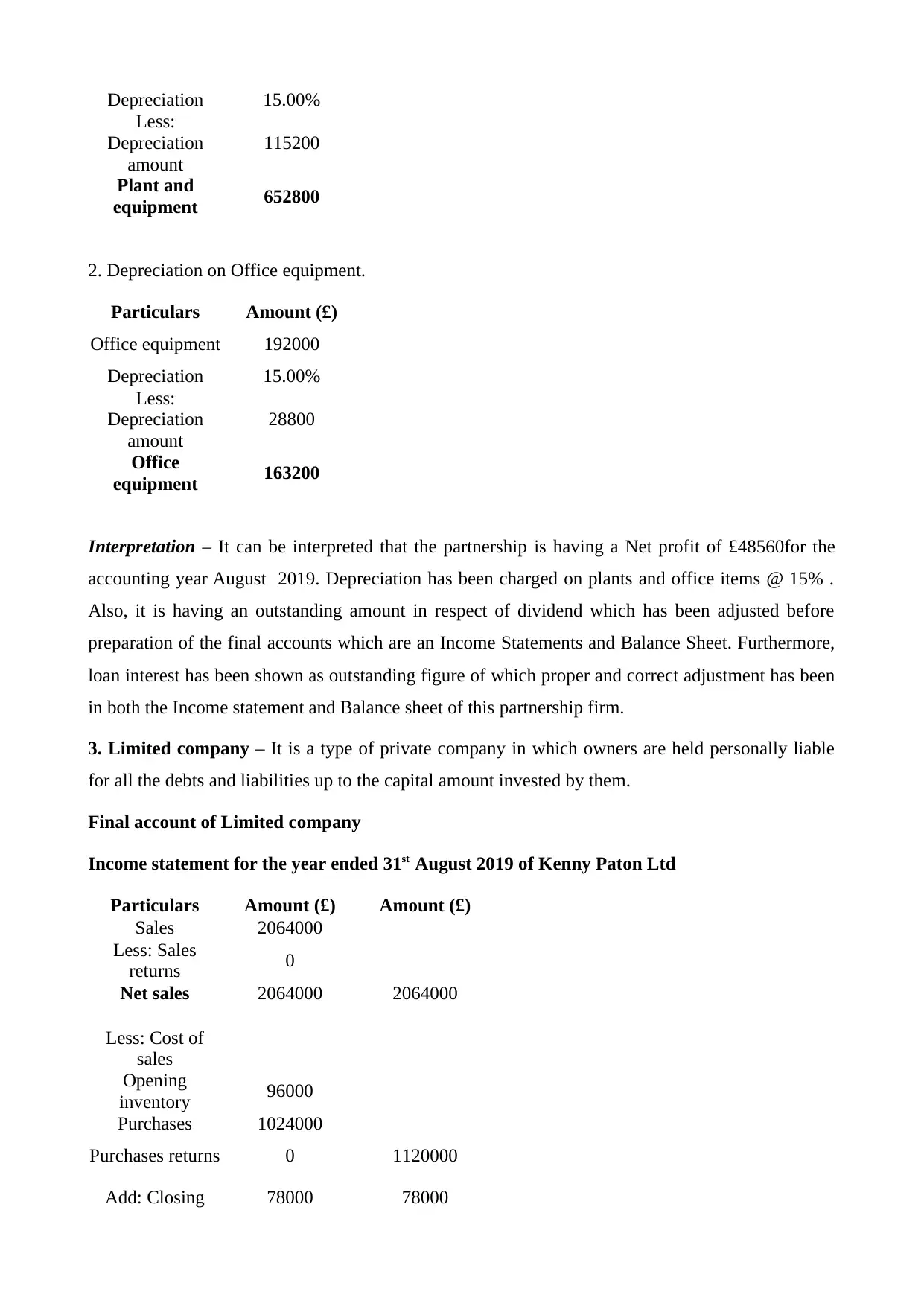
Depreciation 15.00%
Less:
Depreciation
amount
115200
Plant and
equipment 652800
2. Depreciation on Office equipment.
Particulars Amount (£)
Office equipment 192000
Depreciation 15.00%
Less:
Depreciation
amount
28800
Office
equipment 163200
Interpretation – It can be interpreted that the partnership is having a Net profit of £48560for the
accounting year August 2019. Depreciation has been charged on plants and office items @ 15% .
Also, it is having an outstanding amount in respect of dividend which has been adjusted before
preparation of the final accounts which are an Income Statements and Balance Sheet. Furthermore,
loan interest has been shown as outstanding figure of which proper and correct adjustment has been
in both the Income statement and Balance sheet of this partnership firm.
3. Limited company – It is a type of private company in which owners are held personally liable
for all the debts and liabilities up to the capital amount invested by them.
Final account of Limited company
Income statement for the year ended 31st August 2019 of Kenny Paton Ltd
Particulars Amount (£) Amount (£)
Sales 2064000
Less: Sales
returns 0
Net sales 2064000 2064000
Less: Cost of
sales
Opening
inventory 96000
Purchases 1024000
Purchases returns 0 1120000
Add: Closing 78000 78000
Less:
Depreciation
amount
115200
Plant and
equipment 652800
2. Depreciation on Office equipment.
Particulars Amount (£)
Office equipment 192000
Depreciation 15.00%
Less:
Depreciation
amount
28800
Office
equipment 163200
Interpretation – It can be interpreted that the partnership is having a Net profit of £48560for the
accounting year August 2019. Depreciation has been charged on plants and office items @ 15% .
Also, it is having an outstanding amount in respect of dividend which has been adjusted before
preparation of the final accounts which are an Income Statements and Balance Sheet. Furthermore,
loan interest has been shown as outstanding figure of which proper and correct adjustment has been
in both the Income statement and Balance sheet of this partnership firm.
3. Limited company – It is a type of private company in which owners are held personally liable
for all the debts and liabilities up to the capital amount invested by them.
Final account of Limited company
Income statement for the year ended 31st August 2019 of Kenny Paton Ltd
Particulars Amount (£) Amount (£)
Sales 2064000
Less: Sales
returns 0
Net sales 2064000 2064000
Less: Cost of
sales
Opening
inventory 96000
Purchases 1024000
Purchases returns 0 1120000
Add: Closing 78000 78000
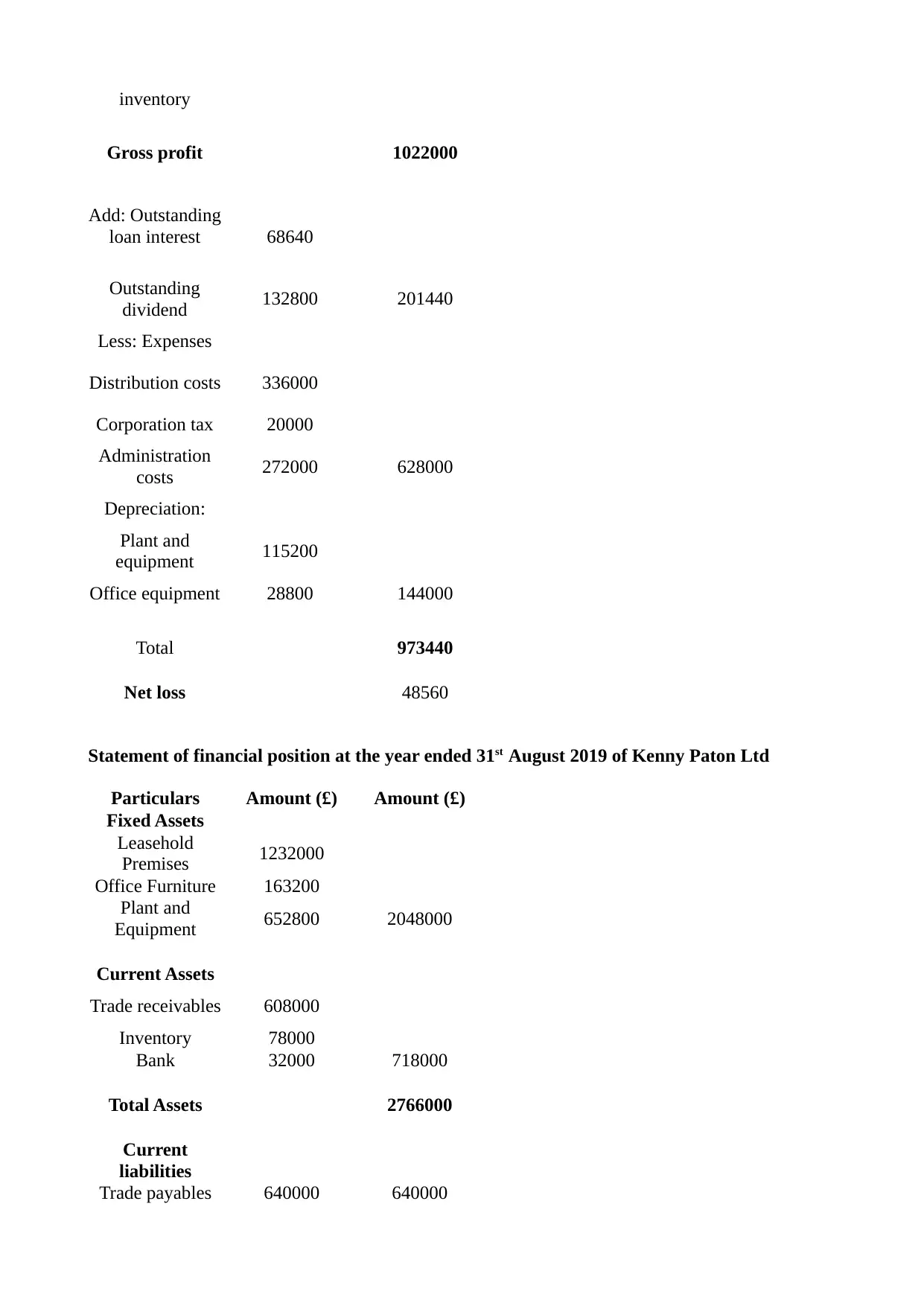
inventory
Gross profit 1022000
Add: Outstanding
loan interest 68640
Outstanding
dividend 132800 201440
Less: Expenses
Distribution costs 336000
Corporation tax 20000
Administration
costs 272000 628000
Depreciation:
Plant and
equipment 115200
Office equipment 28800 144000
Total 973440
Net loss 48560
Statement of financial position at the year ended 31st August 2019 of Kenny Paton Ltd
Particulars Amount (£) Amount (£)
Fixed Assets
Leasehold
Premises 1232000
Office Furniture 163200
Plant and
Equipment 652800 2048000
Current Assets
Trade receivables 608000
Inventory 78000
Bank 32000 718000
Total Assets 2766000
Current
liabilities
Trade payables 640000 640000
Gross profit 1022000
Add: Outstanding
loan interest 68640
Outstanding
dividend 132800 201440
Less: Expenses
Distribution costs 336000
Corporation tax 20000
Administration
costs 272000 628000
Depreciation:
Plant and
equipment 115200
Office equipment 28800 144000
Total 973440
Net loss 48560
Statement of financial position at the year ended 31st August 2019 of Kenny Paton Ltd
Particulars Amount (£) Amount (£)
Fixed Assets
Leasehold
Premises 1232000
Office Furniture 163200
Plant and
Equipment 652800 2048000
Current Assets
Trade receivables 608000
Inventory 78000
Bank 32000 718000
Total Assets 2766000
Current
liabilities
Trade payables 640000 640000
⊘ This is a preview!⊘
Do you want full access?
Subscribe today to unlock all pages.

Trusted by 1+ million students worldwide
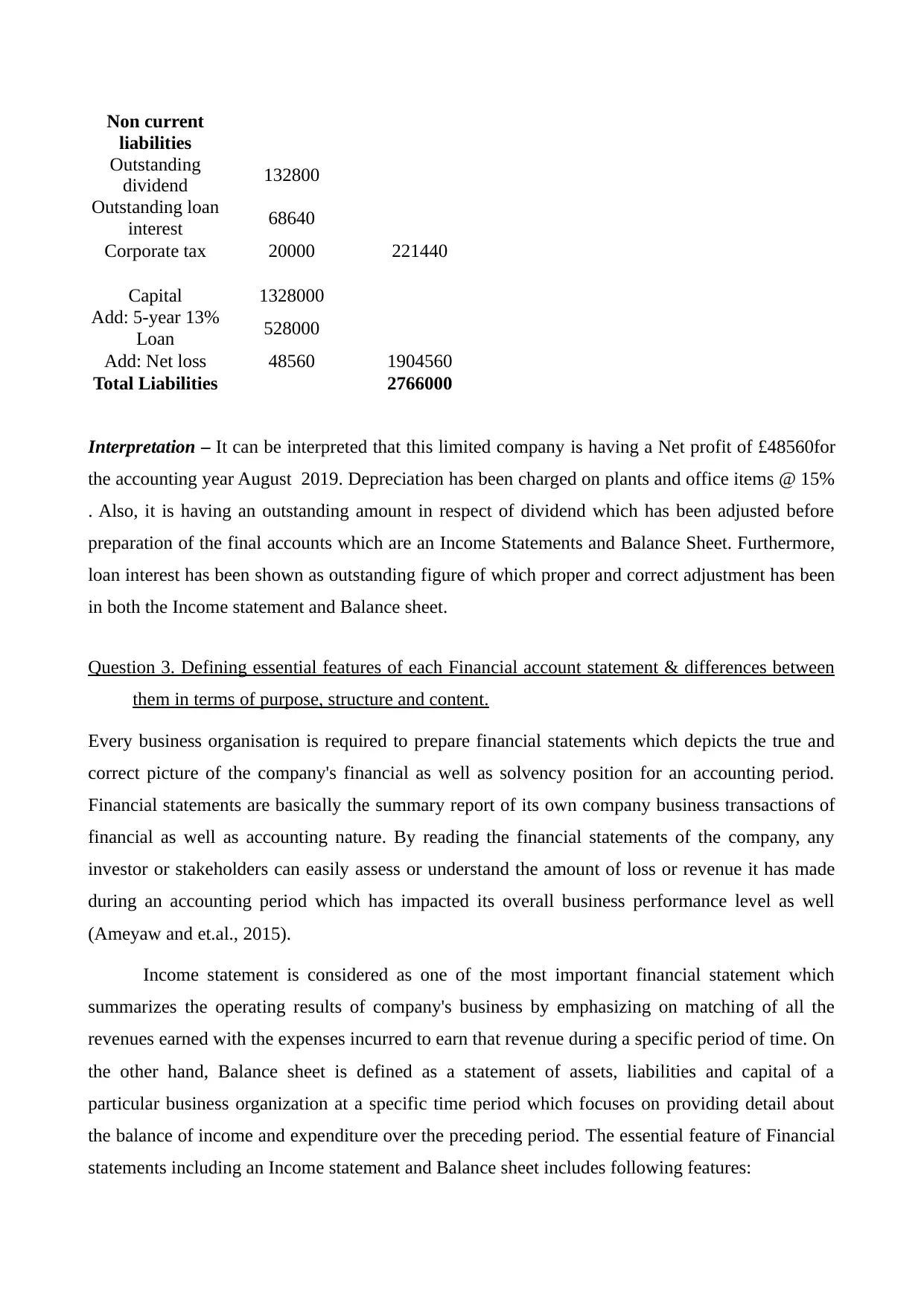
Non current
liabilities
Outstanding
dividend 132800
Outstanding loan
interest 68640
Corporate tax 20000 221440
Capital 1328000
Add: 5-year 13%
Loan 528000
Add: Net loss 48560 1904560
Total Liabilities 2766000
Interpretation – It can be interpreted that this limited company is having a Net profit of £48560for
the accounting year August 2019. Depreciation has been charged on plants and office items @ 15%
. Also, it is having an outstanding amount in respect of dividend which has been adjusted before
preparation of the final accounts which are an Income Statements and Balance Sheet. Furthermore,
loan interest has been shown as outstanding figure of which proper and correct adjustment has been
in both the Income statement and Balance sheet.
Question 3. Defining essential features of each Financial account statement & differences between
them in terms of purpose, structure and content.
Every business organisation is required to prepare financial statements which depicts the true and
correct picture of the company's financial as well as solvency position for an accounting period.
Financial statements are basically the summary report of its own company business transactions of
financial as well as accounting nature. By reading the financial statements of the company, any
investor or stakeholders can easily assess or understand the amount of loss or revenue it has made
during an accounting period which has impacted its overall business performance level as well
(Ameyaw and et.al., 2015).
Income statement is considered as one of the most important financial statement which
summarizes the operating results of company's business by emphasizing on matching of all the
revenues earned with the expenses incurred to earn that revenue during a specific period of time. On
the other hand, Balance sheet is defined as a statement of assets, liabilities and capital of a
particular business organization at a specific time period which focuses on providing detail about
the balance of income and expenditure over the preceding period. The essential feature of Financial
statements including an Income statement and Balance sheet includes following features:
liabilities
Outstanding
dividend 132800
Outstanding loan
interest 68640
Corporate tax 20000 221440
Capital 1328000
Add: 5-year 13%
Loan 528000
Add: Net loss 48560 1904560
Total Liabilities 2766000
Interpretation – It can be interpreted that this limited company is having a Net profit of £48560for
the accounting year August 2019. Depreciation has been charged on plants and office items @ 15%
. Also, it is having an outstanding amount in respect of dividend which has been adjusted before
preparation of the final accounts which are an Income Statements and Balance Sheet. Furthermore,
loan interest has been shown as outstanding figure of which proper and correct adjustment has been
in both the Income statement and Balance sheet.
Question 3. Defining essential features of each Financial account statement & differences between
them in terms of purpose, structure and content.
Every business organisation is required to prepare financial statements which depicts the true and
correct picture of the company's financial as well as solvency position for an accounting period.
Financial statements are basically the summary report of its own company business transactions of
financial as well as accounting nature. By reading the financial statements of the company, any
investor or stakeholders can easily assess or understand the amount of loss or revenue it has made
during an accounting period which has impacted its overall business performance level as well
(Ameyaw and et.al., 2015).
Income statement is considered as one of the most important financial statement which
summarizes the operating results of company's business by emphasizing on matching of all the
revenues earned with the expenses incurred to earn that revenue during a specific period of time. On
the other hand, Balance sheet is defined as a statement of assets, liabilities and capital of a
particular business organization at a specific time period which focuses on providing detail about
the balance of income and expenditure over the preceding period. The essential feature of Financial
statements including an Income statement and Balance sheet includes following features:
Paraphrase This Document
Need a fresh take? Get an instant paraphrase of this document with our AI Paraphraser
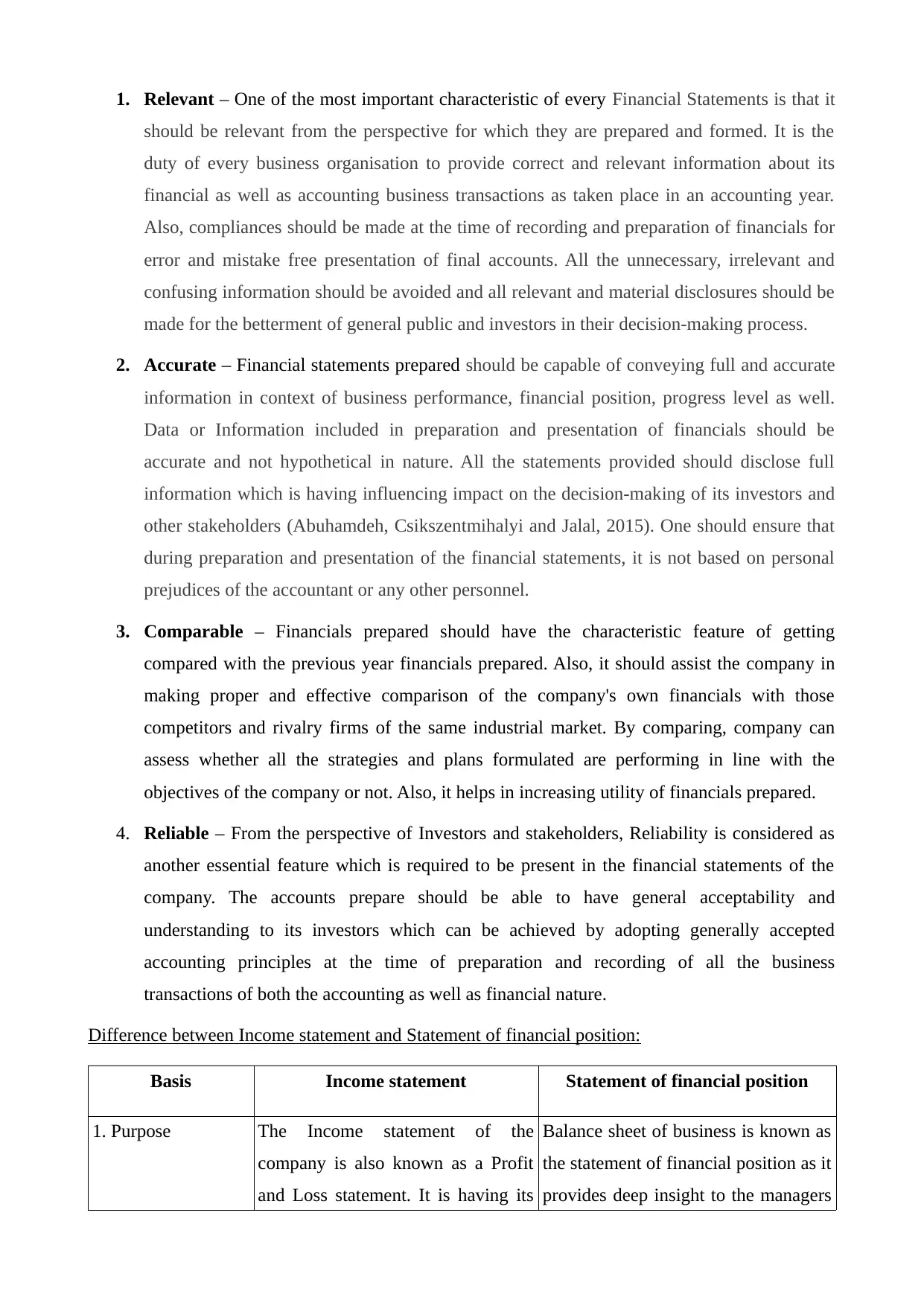
1. Relevant – One of the most important characteristic of every Financial Statements is that it
should be relevant from the perspective for which they are prepared and formed. It is the
duty of every business organisation to provide correct and relevant information about its
financial as well as accounting business transactions as taken place in an accounting year.
Also, compliances should be made at the time of recording and preparation of financials for
error and mistake free presentation of final accounts. All the unnecessary, irrelevant and
confusing information should be avoided and all relevant and material disclosures should be
made for the betterment of general public and investors in their decision-making process.
2. Accurate – Financial statements prepared should be capable of conveying full and accurate
information in context of business performance, financial position, progress level as well.
Data or Information included in preparation and presentation of financials should be
accurate and not hypothetical in nature. All the statements provided should disclose full
information which is having influencing impact on the decision-making of its investors and
other stakeholders (Abuhamdeh, Csikszentmihalyi and Jalal, 2015). One should ensure that
during preparation and presentation of the financial statements, it is not based on personal
prejudices of the accountant or any other personnel.
3. Comparable – Financials prepared should have the characteristic feature of getting
compared with the previous year financials prepared. Also, it should assist the company in
making proper and effective comparison of the company's own financials with those
competitors and rivalry firms of the same industrial market. By comparing, company can
assess whether all the strategies and plans formulated are performing in line with the
objectives of the company or not. Also, it helps in increasing utility of financials prepared.
4. Reliable – From the perspective of Investors and stakeholders, Reliability is considered as
another essential feature which is required to be present in the financial statements of the
company. The accounts prepare should be able to have general acceptability and
understanding to its investors which can be achieved by adopting generally accepted
accounting principles at the time of preparation and recording of all the business
transactions of both the accounting as well as financial nature.
Difference between Income statement and Statement of financial position:
Basis Income statement Statement of financial position
1. Purpose The Income statement of the
company is also known as a Profit
and Loss statement. It is having its
Balance sheet of business is known as
the statement of financial position as it
provides deep insight to the managers
should be relevant from the perspective for which they are prepared and formed. It is the
duty of every business organisation to provide correct and relevant information about its
financial as well as accounting business transactions as taken place in an accounting year.
Also, compliances should be made at the time of recording and preparation of financials for
error and mistake free presentation of final accounts. All the unnecessary, irrelevant and
confusing information should be avoided and all relevant and material disclosures should be
made for the betterment of general public and investors in their decision-making process.
2. Accurate – Financial statements prepared should be capable of conveying full and accurate
information in context of business performance, financial position, progress level as well.
Data or Information included in preparation and presentation of financials should be
accurate and not hypothetical in nature. All the statements provided should disclose full
information which is having influencing impact on the decision-making of its investors and
other stakeholders (Abuhamdeh, Csikszentmihalyi and Jalal, 2015). One should ensure that
during preparation and presentation of the financial statements, it is not based on personal
prejudices of the accountant or any other personnel.
3. Comparable – Financials prepared should have the characteristic feature of getting
compared with the previous year financials prepared. Also, it should assist the company in
making proper and effective comparison of the company's own financials with those
competitors and rivalry firms of the same industrial market. By comparing, company can
assess whether all the strategies and plans formulated are performing in line with the
objectives of the company or not. Also, it helps in increasing utility of financials prepared.
4. Reliable – From the perspective of Investors and stakeholders, Reliability is considered as
another essential feature which is required to be present in the financial statements of the
company. The accounts prepare should be able to have general acceptability and
understanding to its investors which can be achieved by adopting generally accepted
accounting principles at the time of preparation and recording of all the business
transactions of both the accounting as well as financial nature.
Difference between Income statement and Statement of financial position:
Basis Income statement Statement of financial position
1. Purpose The Income statement of the
company is also known as a Profit
and Loss statement. It is having its
Balance sheet of business is known as
the statement of financial position as it
provides deep insight to the managers
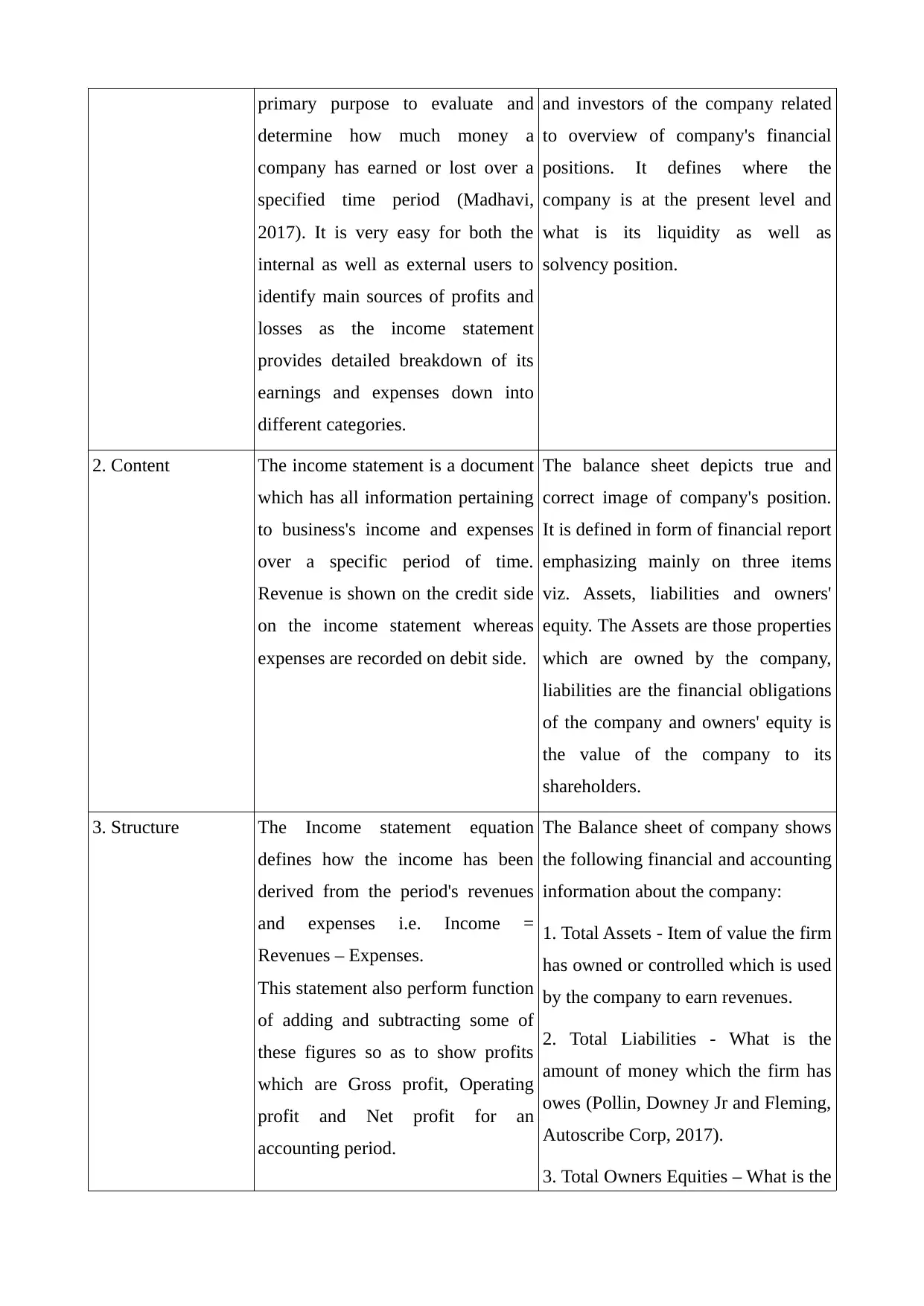
primary purpose to evaluate and
determine how much money a
company has earned or lost over a
specified time period (Madhavi,
2017). It is very easy for both the
internal as well as external users to
identify main sources of profits and
losses as the income statement
provides detailed breakdown of its
earnings and expenses down into
different categories.
and investors of the company related
to overview of company's financial
positions. It defines where the
company is at the present level and
what is its liquidity as well as
solvency position.
2. Content The income statement is a document
which has all information pertaining
to business's income and expenses
over a specific period of time.
Revenue is shown on the credit side
on the income statement whereas
expenses are recorded on debit side.
The balance sheet depicts true and
correct image of company's position.
It is defined in form of financial report
emphasizing mainly on three items
viz. Assets, liabilities and owners'
equity. The Assets are those properties
which are owned by the company,
liabilities are the financial obligations
of the company and owners' equity is
the value of the company to its
shareholders.
3. Structure The Income statement equation
defines how the income has been
derived from the period's revenues
and expenses i.e. Income =
Revenues – Expenses.
This statement also perform function
of adding and subtracting some of
these figures so as to show profits
which are Gross profit, Operating
profit and Net profit for an
accounting period.
The Balance sheet of company shows
the following financial and accounting
information about the company:
1. Total Assets - Item of value the firm
has owned or controlled which is used
by the company to earn revenues.
2. Total Liabilities - What is the
amount of money which the firm has
owes (Pollin, Downey Jr and Fleming,
Autoscribe Corp, 2017).
3. Total Owners Equities – What is the
determine how much money a
company has earned or lost over a
specified time period (Madhavi,
2017). It is very easy for both the
internal as well as external users to
identify main sources of profits and
losses as the income statement
provides detailed breakdown of its
earnings and expenses down into
different categories.
and investors of the company related
to overview of company's financial
positions. It defines where the
company is at the present level and
what is its liquidity as well as
solvency position.
2. Content The income statement is a document
which has all information pertaining
to business's income and expenses
over a specific period of time.
Revenue is shown on the credit side
on the income statement whereas
expenses are recorded on debit side.
The balance sheet depicts true and
correct image of company's position.
It is defined in form of financial report
emphasizing mainly on three items
viz. Assets, liabilities and owners'
equity. The Assets are those properties
which are owned by the company,
liabilities are the financial obligations
of the company and owners' equity is
the value of the company to its
shareholders.
3. Structure The Income statement equation
defines how the income has been
derived from the period's revenues
and expenses i.e. Income =
Revenues – Expenses.
This statement also perform function
of adding and subtracting some of
these figures so as to show profits
which are Gross profit, Operating
profit and Net profit for an
accounting period.
The Balance sheet of company shows
the following financial and accounting
information about the company:
1. Total Assets - Item of value the firm
has owned or controlled which is used
by the company to earn revenues.
2. Total Liabilities - What is the
amount of money which the firm has
owes (Pollin, Downey Jr and Fleming,
Autoscribe Corp, 2017).
3. Total Owners Equities – What is the
⊘ This is a preview!⊘
Do you want full access?
Subscribe today to unlock all pages.

Trusted by 1+ million students worldwide
1 out of 19
Related Documents
Your All-in-One AI-Powered Toolkit for Academic Success.
+13062052269
info@desklib.com
Available 24*7 on WhatsApp / Email
![[object Object]](/_next/static/media/star-bottom.7253800d.svg)
Unlock your academic potential
Copyright © 2020–2025 A2Z Services. All Rights Reserved. Developed and managed by ZUCOL.





